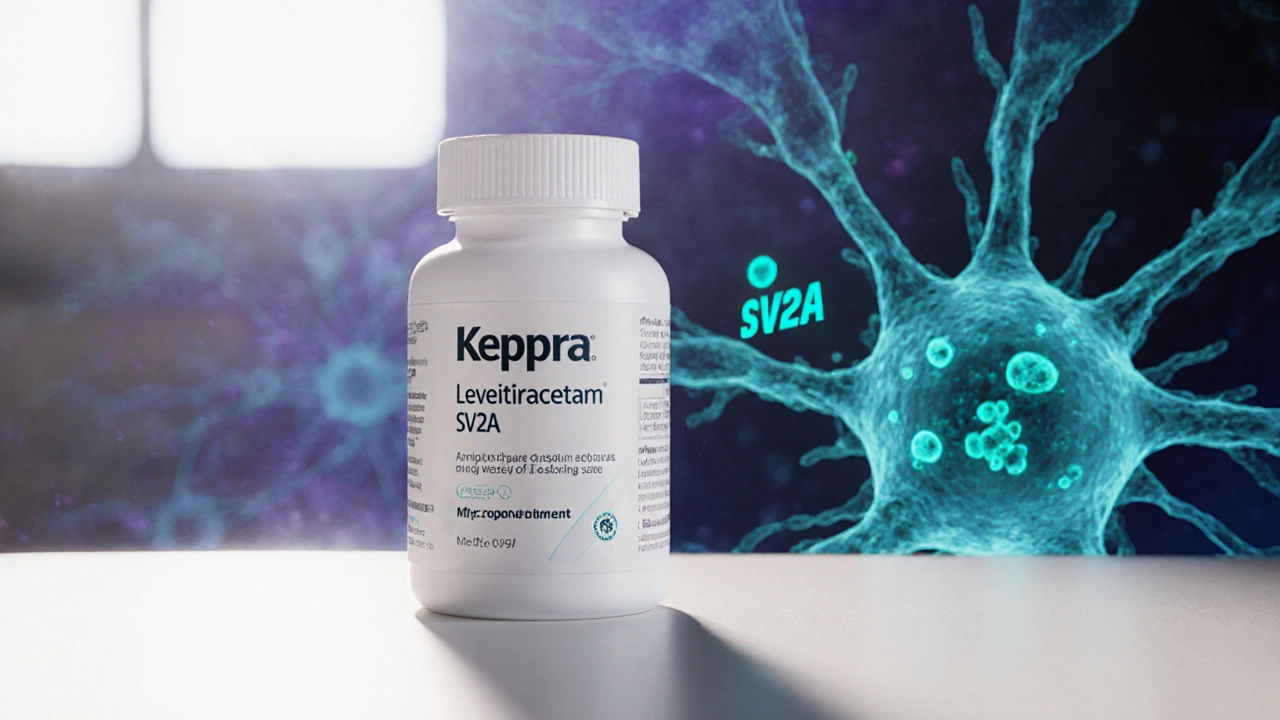Keppra vs Other Anti‑Seizure Drugs: How Levetiracetam Stacks Up

Anti-Seizure Medication Comparison Tool
How This Tool Works
Select your key criteria to see which anti-seizure medications might best suit your situation. This tool compares Keppra with other common AEDs based on your inputs. Remember: always consult your neurologist before making treatment changes.
If you or a loved one is managing epilepsy, you’ve probably heard the name Keppra. It’s one of the most prescribed anti‑seizure medicines, but it isn’t the only option. This guide walks through how Keppra (levetiracetam) measures against the most common alternatives, so you can see which drug fits your lifestyle, symptom pattern, and health goals.
What is Keppra (Levetiracetam)?
Keppra is the brand name for levetiracetam, a second‑generation antiepileptic drug (AED) approved by the FDA in 1999. It works by binding to the synaptic vesicle protein SV2A, modulating neurotransmitter release and stabilizing neuronal firing. The drug is taken orally, comes in tablets, oral solution, and injectable forms, and is approved for partial‑onset, myoclonic, and primary generalized tonic‑clonic seizures.
Why Compare AEDs?
Choosing an AED isn’t just about seizure control. You have to weigh side‑effects, drug interactions, dosing convenience, cost, and how the medication fits with other health conditions. The most common criteria patients look at are:
- Effectiveness for specific seizure types
- Side‑effect profile
- Drug‑drug interactions
- Dosage frequency and titration speed
- Pregnancy safety
- Cost and insurance coverage
Below we’ll see how Keppra stacks up against seven widely used alternatives.
Key Comparison Criteria
Before diving into the table, it helps to understand what each column means:
- Mechanism of Action: How the drug curbs seizures at the cellular level.
- Approved Seizure Types: The seizure classifications the drug treats.
- Common Side‑Effects: The most frequently reported adverse events.
- Drug Interactions: Notable meds that increase risk of toxicity or reduce efficacy.
- Dosing Frequency: How often you need to take the drug.
- Pregnancy Category: Safety rating for use during pregnancy (based on FDA and recent real‑world data).
- Typical Cost (US$): Approximate monthly cost for a standard adult dose, before insurance.
Side‑by‑Side Comparison Table
| Drug | Mechanism | Seizure Types | Common Side‑Effects | Key Interactions | Dosing | Pregnancy | Monthly Cost* |
|---|---|---|---|---|---|---|---|
| Keppra | SV2A binding | Partial‑onset, myoclonic, generalized tonic‑clonic | Drowsiness, irritability, dizziness | Rare; slight increase with carbamazepine | Twice daily | Category C (limited data) | $30‑$45 |
| Valproic Acid | Increases GABA, blocks Na+ channels | Broad‑spectrum (partial, generalized) | Weight gain, tremor, liver enzyme elevation | Carbapenems, warfarin, aspirin | Once or twice daily | Category D (high teratogenic risk) | $20‑$35 |
| Carbamazepine | Na+ channel blocker | Partial‑onset, generalized tonic‑clonic | Hyponatremia, dizziness, rash | Many - oral contraceptives, macrolides, SSRIs | Twice daily | Category C (moderate risk) | $15‑$25 |
| Lamotrigine | Na+ channel stabilizer | Partial‑onset, generalized tonic‑clonic | Skin rash (rare SJS), dizziness | Valproic acid (increases levels) | Once daily (slow titration) | Category C | $25‑$40 |
| Topiramate | Na+ channel blocker, GABA enhancer | Partial‑onset, generalized tonic‑clonic | Kidney stones, cognitive slowing, weight loss | Oral contraceptives, carbonic anhydrase inhibitors | Twice daily | Category C | $30‑$55 |
| Phenytoin | Na+ channel blocker | Generalized tonic‑clonic, partial‑onset | Gingival hyperplasia, hirsutism, ataxia | Warfarin, oral contraceptives, rifampin | Thrice daily | Category D | $10‑$20 |
| Oxcarbazepine | Na+ channel blocker (pro‑drug) | Partial‑onset | Hyponatremia, dizziness | SSRIs, contraceptives | Twice daily | Category C | $20‑$30 |
| Lacosamide | Enhances slow inactivation of Na+ channels | Partial‑onset | Dizziness, nausea, cardiac PR‑interval prolongation | Carbamazepine (increases levels) | Twice daily | Category C | $35‑$60 |
*Costs based on average retail price for a 70‑kg adult in the United States, 2025. Prices vary by pharmacy and insurance.
Deep Dive: How Keppra Differs From the Rest
While the table gives a snapshot, a few nuances matter when you sit down with your neurologist.
- Rapid Titration: Keppra can be up‑titrated quickly (usually within a week) because it has a low risk of severe skin reactions. Lamotrigine, by contrast, requires a slow 8‑week ramp to avoid Stevens‑Johnson syndrome.
- Drug Interactions: Most AEDs are enzyme inducers or inhibitors, meaning they can alter the levels of other meds. Keppra is largely free of cytochrome‑P450 effects, so it plays nicely with birth‑control pills, antidepressants, and anticoagulants.
- Cognitive Impact: Patients often report feeling “foggy” on topiramate or phenobarbital. Keppra’s cognitive side‑effects are generally mild, limited to occasional irritability or dizziness.
- Pregnancy Considerations: Valproic acid and phenytoin carry clear teratogenic warnings (Category D). Keppra sits in Category C - still a caution, but evidence suggests a lower risk of major malformations than valproate.
- Renal vs Hepatic Clearance: Keppra is excreted unchanged in urine, making it a solid choice for patients with liver disease. Drugs like carbamazepine and valproic acid depend heavily on hepatic metabolism.
When Might an Alternative Be a Better Fit?
Every seizure profile is unique. Here are scenarios where another AED could trump Keppra:
- Broad‑Spectrum Seizure Control Needed: If a patient experiences both focal and generalized seizures, valproic acid’s wide‑range efficacy may be preferable.
- Cost Sensitivity: For uninsured patients, older drugs like phenytoin or carbamazepine often cost less than brand‑name Keppra, especially before generic levetiracetam becomes widely available.
- Specific Side‑Effect Profile: If a patient reports significant irritability on Keppra, switching to lamotrigine (which tends to be mood‑neutral) can help.
- Renal Impairment: Because Keppra is renally cleared, severe kidney disease may require dose reduction or an alternative like valproic acid, which is hepatically cleared.
- Pregnancy Planning: Women planning a pregnancy often avoid valproic acid; some choose lamotrigine for its relatively better safety data. Keppra can be retained if seizure control is adequate, but the decision rests on individual risk assessment.

How to Talk to Your Doctor About Switching
Switching AEDs isn’t a DIY project. Here’s a practical checklist you can bring to the appointment:
- Write down your seizure diary (type, frequency, triggers).
- List every medication you’re currently taking, including supplements.
- Note any side‑effects you attribute to Keppra (e.g., mood changes, dizziness).
- Ask about the taper‑and‑switch protocol: most doctors will gradually decrease Keppra while introducing the new drug to avoid breakthrough seizures.
- Discuss insurance coverage and out‑of‑pocket cost estimates for the alternative.
- Confirm follow‑up timing: usually a 4‑week check‑in after the new drug reaches target dose.
Being organized helps the neurologist tailor the plan and reduces the risk of sudden seizure recurrence.
Key Takeaways
- Keppra offers rapid titration, few drug interactions, and moderate cost.
- Alternatives like valproic acid provide broader seizure coverage but carry higher teratogenic and metabolic risks.
- Side‑effect profiles and patient‑specific factors (renal function, pregnancy plans, budget) should drive the final decision.
- Never change AEDs without medical supervision; a structured crossover plan is essential.
Frequently Asked Questions
Can I take Keppra with birth‑control pills?
Yes. Keppra does not affect the hormonal levels in oral contraceptives, making it a safe choice for women who rely on birth‑control.
Why does Keppra sometimes cause irritability?
Levetiracetam can influence neurotransmitter release in brain regions that modulate mood. About 10‑15% of users report mood swings or irritability, especially during dose escalation.
Is a generic version of Keppra available?
Yes. Generic levetiracetam hit the US market in 2022, lowering the price for most insurance plans. However, some patients notice subtle differences in tolerability, so discuss any switch with your prescriber.
How quickly can I expect seizure reduction after starting Keppra?
Because Keppra is rapidly absorbed, many patients notice a drop in seizure frequency within 1‑2 weeks of reaching an effective dose. Full stabilization may take 4‑6 weeks.
What should I do if I miss a Keppra dose?
Take the missed dose as soon as you remember, unless it’s almost time for the next scheduled dose. In that case, skip the missed one and resume your regular schedule - don’t double up.
Understanding the strengths and limits of each medication empowers you to partner with your clinician for the best seizure control. Whether you stay on Keppra or switch to an alternative, the goal remains the same: a life with fewer seizures and more freedom.
Megan C.
October 12, 2025 AT 20:10When people treat their seizures like a hobby, the whole conversation about medication becomes a moral lesson. Keppra may be popular, but it isn’t a blanket solution for everyone. You have to weigh the ethical responsibility of exposing yourself to potential irritability against the benefit of rapid titration. If you ignore the long‑term data on mood changes, you’re essentially gambling with your mental health. So, before you brag about brand names, consider the humble alternatives that respect your body’s chemistry.
Lydia Conier
October 19, 2025 AT 08:10Hey there! This guide is super helpful, but I wish it had a little more on how to transition safely from Keppra to lamotrigine. The step‑by‑step taper can be scary, especially if you’re already dealing with irritability. Also, some of the cost numbers feel a bit off for folks on a tight budget, so maybe add a link to a discount program. Overall great job, just a few tweaks would make it perfect! :)
ruth purizaca
October 25, 2025 AT 20:10Meh.
Shelley Beneteau
November 1, 2025 AT 08:10I appreciate how thorough this article is, especially the sections on renal versus hepatic clearance. It would be useful to see more about how cultural factors influence drug choice, like patient preferences in different regions. Also, could you elaborate on how the titration schedule adapts for elderly patients? Thanks for the clear explanation.
Sonya Postnikova
November 7, 2025 AT 20:10Great rundown! I love how you highlighted the low interaction profile of Keppra – that’s a lifesaver for folks on multiple meds. The pregnancy section is also spot‑on; many people overlook that nuance. Keep the friendly tone, it really makes the dense info approachable. 😊
Anna Zawierucha
November 14, 2025 AT 08:10Oh, so you think Keppra’s side‑effects are "mild"? Sure, if you enjoy a side‑effect cocktail of irritability, dizziness, and occasional mood swings. Nothing says "good vibes" like a drug that makes you question your own temperament.
Glenn Gould
November 20, 2025 AT 20:10Yo, this is awesome! I was thinkin about trying Keppra but was scared of the cost. Good to know generic levetiracetam is cheaper now. Plus, the quick titration means I won’t be waitin forever to see results. Thanks for the heads up!
Poonam Sharma
November 27, 2025 AT 08:10Listen, fellow pharmacists, the Indian market *needs* more transparency on drug pricing. Keppra is hailed as a miracle in the West, yet here we battle inflated tariffs and limited generic options. The article’s cost analysis ignores the massive subsidy gaps that affect our patients. If we’re truly global, we must address these disparities, not just parade US‑centric numbers. The jargon about "renal clearance" is fine, but where’s the discussion on accessibility in low‑resource settings?
Meigan Chiu
December 3, 2025 AT 20:10Actually, the claim that Keppra is "Category C" is outdated; recent FDA updates place it in a more nuanced risk category. Also, the sentence "Keppra does not affect hormonal levels" lacks a citation. Please revise for accuracy.